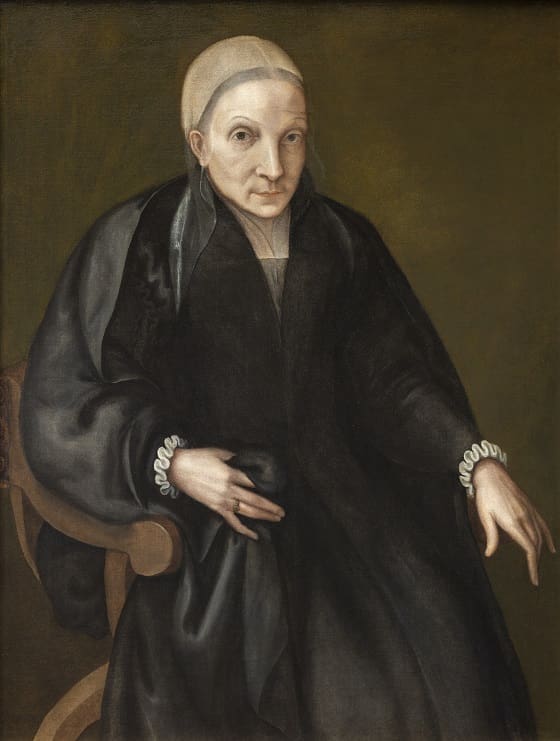Europa Anguissola
Portrait of the artist’s mother in law, 1571-1578
Oil on canvas, 98 x 78 cm.
Inventory number: 0002NMK
Bought, 1911
An older woman sits in a wooden armchair and gazes out at the viewer. She is dressed in a long, dark dress in the northern Italian style. Over her tight middle parting, she wears a headcloth and transparent veil. The face is unusual with thin lips and deep, round eye sockets. Her expression is serious and aware, but also gentle and alert. It is not just any woman who is portrayed here. The painting has previously been considered a self-portrait by Sofonisba Anguissola, but was probably painted by an artist influenced by her. Sofonisba became a legend in her own time and had many imitators. The portrait is rich in painterly qualities and lovely details such as the depiction of the skin on her face, hands and lips, painted with fine brushes and extremely thin paint layers tinted with pink, blue and green. This colour combination, where the subtle shadows appear grey, provides a sensuous experience of the fine, parchment-thin skin.
When The Nivaagaard Collection’s founder, Johannes Hage, bought the painting with the former titel Portrait of an Old Woman in 1912, it was believed that it was Sofonisba Anguissola’s (ca. 1532-1625) last self-portrait. In the 90s, however, scholars came to doubt that Sofonisba was the artist, and the work was instead attributed to ‘the circle of the Anguissola sisters’. The work is from the Italian Renaissance, but some details are less elaborate than Sofonisba would have painted them and the woman it shows is much older than Sofonisba was at the time it was made.
In connection with the museum's work with the special exhibition Sofonisba - History's Forgotten Miracle in 2022, researcher Michael Cole came to the discovery that it is Sofonisba's sister Europa Anguissola who is the artist behind the portrait depicting her mother-in-law.
Europa Anguissola
Europa Anguissola (c. 1542 – 1578) was schooled in the art of painting by her older sister Sofonisba Anguissola, who was well known in her time for her lively and incisive paintings, and for being the lady-in-waiting and art teacher of the Spanish Queen Elisabeth of Valois. Both sisters were born in Cremona, northern Italy, to a noble family, and Europa also produced many excellent portraits from a young age, earning her praise from Giorgio Vasari in connection with his mention of Sofonisba. Europa Anguissola was married to nobleman Carlo Schinchinelli.
Her portrait in The Nivaagaard Collection is now known as one of just three secure surviving works by Europa Anguissola. It is the only painting by the artist in a public collection, her only certain secular work and the only known work by her outside Italy - the other two are altarpieces in Italian churches.


